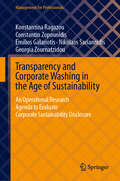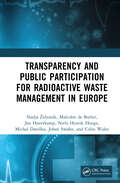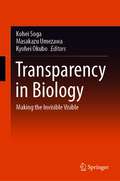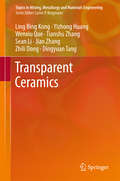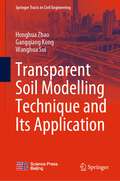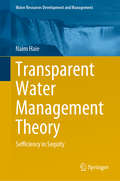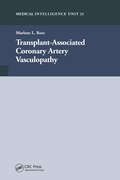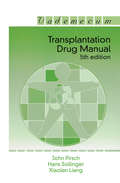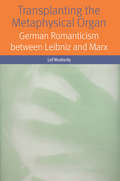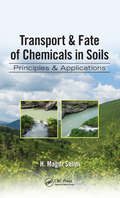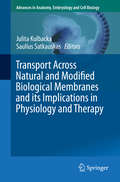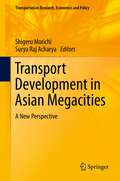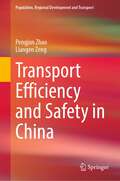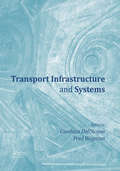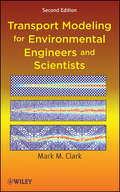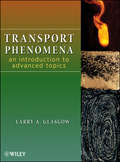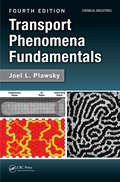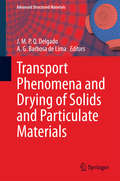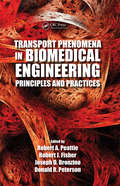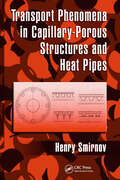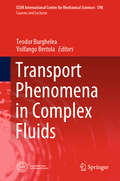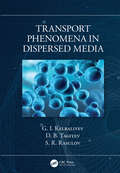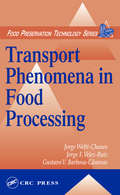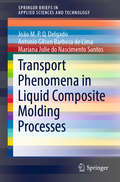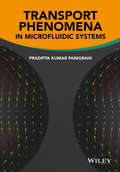- Table View
- List View
Transparency and Corporate Washing in the Age of Sustainability: An Operational Research Agenda to Evaluate Corporate Sustainability Disclosure (Management for Professionals)
by Constantin Zopounidis Emilios Galariotis Konstantina Ragazou Nikolaos Sariannidis Georgia ZournatzidouThis book provides a comprehensive analysis of the various frameworks associated with financial corporate washing. It examines the factors influencing these practices and explores their connection to environmental, social, and governance (ESG) strategies, through the use of operations research methods. ESG investors thoroughly evaluate a company's environmental, social, and governance factors before investing, reflecting the growing global emphasis on sustainability. As climate change risks rise and sustainability becomes more important, many organizations have begun to adapt, though some resort to greenwashing, misleadingly presenting their practices as eco-friendly despite ongoing harmful activities. This book offers a thorough examination of the strategies used by financial institutions, such as greenwashing, bluewashing, social washing, and pinkwashing. It aims to address corporate washing by highlighting its various forms within the financial sector, providing policymakers and stakeholders with insights to develop effective strategies and practices to counteract these deceptive practices.
Transparency and Public Participation for Radioactive Waste Management in Europe
by Nadja Železnik Jan Haverkamp Niels Henrik Hooge Michal Daniška Johan Swahn Colin Wales Malcolm de ButlerTransparency and Public Participation for Radioactive Waste Management in Europe investigates how the pillars of the Aarhus Convention, and a broader understanding of transparency by Civil Society (CS), can be transposed into Radioactive Waste Management (RWM), particularly in the establishment of Radioactive Waste (RW) facilities in different national contexts.With an analysis of nine national cases from Europe, the book provides the results of the investigations, including comments, suggestions, questions, and other observations, collected in interaction with other EURAD-1 participants from civil society. It discusses the feedback provided within a questionnaire completed by ROUTES members for the development of national programmes on radioactive waste management submitted to the waste directive, based on effective access to information, public participation, justice, resources, and transparency.The book will interest nuclear energy policymakers, government employees, and radioactive waste management facility operators. It will also aid researchers and academics investigating public perception and facility siting considerations.
Transparency in Biology: Making the Invisible Visible
by Kohei Soga Masakazu Umezawa Kyohei OkuboThis book explains transparency in biology with emphasis on bending and absorption, which together are the essence of transparency. The reader is provided with an understanding of why the interior of the body can be made to appear transparent through the application of elementary physics. Based on the principle of transparency, emerging imaging techniques using near-infrared light to view the body transparently are explained with examples such as cancer detection and temperature imaging of deep tissues. This book is useful to many researchers, including biologists, physicists, chemists, materials scientists, and device engineers as well as developers—all who seek a deep understanding of transparency in bioimaging.
Transparent Ceramics
by Ling Bing Kong Y. Z. Huang W. X. Que T. S. Zhang S. Li J. Zhang Z. L. Dong D. Y. TangThis book covers the latest progress in the field of transparent ceramics, emphasizing their processing as well as solid-state lasers. It consists of 10 chapters covering the synthesis, characterization and compaction, fundamentals of sintering, densification of transparent ceramics by different methods as well as transparent ceramic applications. This book can be used as a reference for senior undergraduate to postgraduate students, researchers, engineers and material scientists working in solid-state physics.
Transparent Soil Modelling Technique and Its Application (Springer Tracts in Civil Engineering)
by Honghua Zhao Gangqiang Kong Wanghua SuiThis book systematically introduces the advancement of transparent soil modelling technique and its application. The transparent soil modelling technique provides an essential tool for visualizing soil-structure interaction and other geotechnical problems such as grouting, soil plugging. The geotechnical properties of the newest transparent soils were reported on model sand, clay and rock. In addition, more advanced image processing methods were summarized. In this book, numerous applications of transparent soil modelling techniques for different geotechnical problems were presented, and the results obtained are supplemented by numerical calculation and theoretical analysis.
Transparent Water Management Theory: Sefficiency in Sequity (Water Resources Development and Management)
by Naim HaieThis book provides a solid foundation for a comprehensive, systemic and water-centric approach to water management. Said approach integrates two performance principles essential for sustainable water use systems, namely equity and efficiency. Further, it decreases the policy space for decision-making encountered by water managers and makes it easier to arrive at reasonable solutions because of the bounded rationality inherent in its development. By combining the distributive and aggregative principles, the approach offers a transparent and autonomous structure for gathering water data and enabling stakeholder involvement. Lastly, it employs and promotes a unifying language for all types of water use systems, e.g. urban, agricultural and industrial.
Transplant-Associated Coronary Artery Vasculopathy
by Rohit N. KulkarniCardiac transplantation has had a major impact on the quality of life and longevity of an ever-increasing number of patients. This benefit is significantly eroded by the development of an accelerated form of coronary arterial disease which shows some, but not all, of the characteristics of native coronary artery disease, and itself is one of the ma
Transplantation Drug Manual
by John D. Pirsch Hans Sollinger Liang XiaolanThe field of transplantation continues to evolve. In the years since the first publication of the Transplantation Drug Pocket Reference Guide, the therapeutic armamentarium for transplantation has grown. The introduction of new agents continues to enhance our ability to improve the short- and long-term success of transplantation.The fifth edition o
Transplanting the Metaphysical Organ: German Romanticism between Leibniz and Marx (Forms of Living)
by Leif WeatherbyAround 1800, German romanticism developed a philosophy this study calls “Romantic organology.” Scientific and philosophical notions of biological function and speculative thought converged to form the discourse that Transplanting the Metaphysical Organ reconstructs—a metaphysics meant to theorize, and ultimately alter, the structure of a politically and scientifically destabilized world.
Transport & Fate of Chemicals in Soils: Principles & Applications
by H. Magdi SelimDuring the last four decades, tremendous advances have been made towards the understanding of transport characteristics of contaminants in soils, solutes, and tracers in geological media. Transport & Fate of Chemicals in Soils: Principles & Applications offers a comprehensive treatment of the subject complete with supporting examples of mat
Transport Across Natural and Modified Biological Membranes and its Implications in Physiology and Therapy
by Julita Kulbacka Saulius SatkauskasThis book elucidates the mechanisms involved in biological membrane functions. It describes the new modalities and characterization for basic in vitro as well as computer models of biological membranes. Biological membranes are analyzed in terms of advances in molecular dynamics. The individual chapters provide an in depth analysis of images from various biological models. The potential of membrane models in the context of treatment trials is discussed. The authors present new insights and current concepts for treatment procedures (nanocarriers, electroporation, channel blockers).
Transport Development in Asian Megacities: A New Perspective
by Shigeru Morichi Surya Raj AcharyaThe rapid growth of the Asian urban population concentrates on a few large cities, turning them into giant megacities. Despite new theoretical insights into the benefits of megacities, the emerging Asia is facing a daunting challenge concerning the management of infrastructure and services in their megacities. The deteriorating urban mobility is the most difficult challenge with respect to the sharp increase in vehicle numbers and to inadequate and poorly managed road infrastructure. Public transport, a sustainable mode of mobility, is subjected to a vicious cycle of poor service, decreasing ridership and lower investment. Despite various policy initiatives, the situation has not improved. The scale and growth pattern of Asian megacities have distinctive features which generate a unique set of challenges and opportunities. New perspectives are needed to effectively address the transportation problems making the best use of available opportunities. This book, which is a result of an international collaborative research, addresses these challenges by providing insightful analysis and novel viewpoints.
Transport Efficiency and Safety in China (Population, Regional Development and Transport)
by Pengjun Zhao Liangen ZengThis book is the first comprehensive analysis of transport efficiency in China. It presents a series of rigorous empirical analysis for the operation and environmental efficiencies of major transport sectors, including highway, railway, civil aviation, and waterway. It also evaluates transport safety of China. The book innovatively employs a DEA model based on Epsilon measures (EBM) to evaluate transport efficiency and an EBM DEA model with undesirable outputs to calculate transport environmental efficiency. The factors of transport efficiency are quantitatively studied, including economic growth, social transition, and technology changes. Also, China's policies aimed at improving transportation efficiency are evaluated.The theoretical analyses and discussions would enhance our existing knowledge of the changes and determinants of transport system’s efficiency in a context of rapid urbanization, industrialization, and marketization in China. The findings of the existing policy evaluation would bring fresh evidences for transport policy performances to both scholars and politicians. In particular, it shows policymakers the experiences or lessons of how to create an efficient transport system in order to save energy use, reduce GHGs emissions, and improve social security. This book is of great interest to scholars interested in sustainable transport, regional planning and development, environmental policy and is relevant to China and other developing countries.
Transport Infrastructure and Systems: Proceedings of the AIIT International Congress on Transport Infrastructure and Systems (Rome, Italy, 10-12 April 2017)
by Fred Wegman Gianluca Dell’AcquaTransport InfrastructureAsset management in transport infrastructure, financial viability of transport engineering projects/ Life cycle Cost Analysis, Life-Cycle Assessment and Sustainability Assessment of transport infrastructure/ Infrastructures financing and pricing with equity appraisal, operation optimization and energy management/ Low-Volume roads: planning, maintenance, operations, environmental and social issues/ Public-Private Partnership (PPP) experience in transport infrastructure in different countries and economic conditions/ Airport Pavement Management Systems, runway design and maintenance/ Port maintenance and development issues, technology relating to cargo handling, landside access, cruise operations/ Infrastructure Building Information Modelling (I-BIM) / Pavement design and innovative bituminous materials/ Recycling and re-use in road pavements, environmentally sustainable technologies/ Stone pavements, ancient roads and historic railways/ Cementitious stabilization of materials used in the rehabilitation of transportation infrastructure. Transport SystemsSustainable transport and the environment protection including green vehicles/ Urban transport, land use development, spatial and transport planning/ Bicycling, bike, bike-sharing systems, cycling mobility/ Human factor in transport systems/ Intelligent Mobility: emerging technologies to enable the smarter movement of people and goods/Airport landside: access roads, parking facilities, terminal facilities, aircraft apron and the azdjacent taxiway/ Transportation policy, planning and design, modelling and decision making/ Transport economics, finance and pricing issues, optimization problems, equity appraisal/ Road safety impact assessments, road safety audits, the management of road network safety and safety inspections/ Tunnels and underground structures: preventing incidents-accidents mitigating their effects for both people and goods/ Traffic flow characteristics, traffic control devices, work zone traffic control, highway capacity and quality of service/ Track-vehicle interactions in railway systems, capacity analysis of railway networks/ Risk assessment and safety in air and railway transport, reliability aspects/ Maritime transport and inland waterways transport research/ Intermodal freight transport: terminals and logistics.
Transport Modeling for Environmental Engineers and Scientists
by Mark M. ClarkTransport Modeling for Environmental Engineers and Scientists, Second Edition, builds on integrated transport courses in chemical engineering curricula, demonstrating the underlying unity of mass and momentum transport processes. It describes how these processes underlie the mechanics common to both pollutant transport and pollution control processes.
Transport Phenomena
by Larry A. GlasgowEnables readers to apply transport phenomena principles to solve advanced problems in all areas of engineering and science This book helps readers elevate their understanding of, and their ability to apply, transport phenomena by introducing a broad range of advanced topics as well as analytical and numerical solution techniques. Readers gain the ability to solve complex problems generally not addressed in undergraduate-level courses, including nonlinear, multidimensional transport, and transient molecular and convective transport scenarios. Avoiding rote memorization, the author emphasizes a dual approach to learning in which physical understanding and problem-solving capability are developed simultaneously. Moreover, the author builds both readers' interest and knowledge by: Demonstrating that transport phenomena are pervasive, affecting every aspect of life Offering historical perspectives to enhance readers' understanding of current theory and methods Providing numerous examples drawn from a broad range of fields in the physical and life sciences and engineering Contextualizing problems in scenarios so that their rationale and significance are clear This text generally avoids the use of commercial software for problem solutions, helping readers cultivate a deeper understanding of how solutions are developed. References throughout the text promote further study and encourage the student to contemplate additional topics in transport phenomena. Transport Phenomena is written for advanced undergraduates and graduate students in chemical and mechanical engineering. Upon mastering the principles and techniques presented in this text, all readers will be better able to critically evaluate a broad range of physical phenomena, processes, and systems across many disciplines.
Transport Phenomena Fundamentals (Chemical Industries)
by Joel L. PlawskyThe fourth edition of Transport Phenomena Fundamentals continues with its streamlined approach to the subject, based on a unified treatment of heat, mass, and momentum transport using a balance equation approach. The new edition includes more worked examples within each chapter and adds confidence-building problems at the end of each chapter. Some numerical solutions are included in an appendix for students to check their comprehension of key concepts. Additional resources online include exercises that can be practiced using a wide range of software programs available for simulating engineering problems, such as, COMSOL®, Maple®, Fluent, Aspen, Mathematica, Python and MATLAB®, lecture notes, and past exams. This edition incorporates a wider range of problems to expand the utility of the text beyond chemical engineering. The text is divided into two parts, which can be used for teaching a two-term course. Part I covers the balance equation in the context of diffusive transport—momentum, energy, mass, and charge. Each chapter adds a term to the balance equation, highlighting that term's effects on the physical behavior of the system and the underlying mathematical description. Chapters familiarize students with modeling and developing mathematical expressions based on the analysis of a control volume, the derivation of the governing differential equations, and the solution to those equations with appropriate boundary conditions. Part II builds on the diffusive transport balance equation by introducing convective transport terms, focusing on partial, rather than ordinary, differential equations. The text describes paring down the full, microscopic equations governing the phenomena to simplify the models and develop engineering solutions, and it introduces macroscopic versions of the balance equations for use where the microscopic approach is either too difficult to solve or would yield much more information that is actually required. The text discusses the momentum, Bernoulli, energy, and species continuity equations, including a brief description of how these equations are applied to heat exchangers, continuous contactors, and chemical reactors. The book introduces the three fundamental transport coefficients: the friction factor, the heat transfer coefficient, and the mass transfer coefficient in the context of boundary layer theory. Laminar flow situations are treated first followed by a discussion of turbulence. The final chapter covers the basics of radiative heat transfer, including concepts such as blackbodies, graybodies, radiation shields, and enclosures.
Transport Phenomena and Drying of Solids and Particulate Materials
by J. M. P. Q. Delgado A. G. Barbosa de LimaThe purpose of this book, Transport Phenomena and Drying of Solids and Particulate Materials, is to provide a collection of recent contributions in the field of heat and mass transfer, transport phenomena, drying and wetting of solids and particulate materials. The main benefit of the book is that it discusses some of the most important topics related to the heat and mass transfer in solids and particulate materials. It includes a set of new developments in the field of basic and applied research work on the physical and chemical aspects of heat and mass transfer phenomena, drying and wetting processes, namely, innovations and trends in drying science and technology, drying mechanism and theory, equipment, advanced modelling, complex simulation and experimentation. At the same time, these topics will be going to the encounter of a variety of scientific and engineering disciplines. The book is divided in several chapters that intend to be a resume of the current state of knowledge for benefit of professional colleagues.
Transport Phenomena in Biomedical Engineering: Principles and Practices
by Joseph D. Bronzino Donald R. Peterson Robert A. Peattie Robert J. FisherDesign, analysis and simulation of tissue constructs is an integral part of the ever-evolving field of biomedical engineering. The study of reaction kinetics, particularly when coupled with complex physical phenomena such as the transport of heat, mass and momentum, is required to determine or predict performance of biologically-based systems wheth
Transport Phenomena in Capillary-Porous Structures and Heat Pipes
by Henry SmirnovTwo-phase nano- and micro-thermal control device research is now proving relevant to a growing range of modern applications, including those in cryogenics, thermal engineering, MEMS, and aerospace engineering. Until now, researchers have lacked a definitive resource that provides a complete review of micro- and nano-scale evaporative heat and mass
Transport Phenomena in Complex Fluids (CISM International Centre for Mechanical Sciences #598)
by Teodor Burghelea Volfango BertolaThis book provides a thorough overview of transport phenomena in complex fluids, based on the latest research results and the newest methods for their analytical prediction and numerical simulation. The respective chapters cover several topics, including: a description of the structural features of the most common complex fluids (polymer and surfactant solutions, colloidal suspensions); an introduction to the most common non-Newtonian constitutive models and their relationship with the fluid microstructure; a detailed overview of the experimental methods used to characterise the thermophysical properties, bulk rheology, and surface properties of complex fluids; a comprehensive introduction to heat, mass, and momentum transport, and to hydrodynamic instabilities in complex fluids; and an introduction to state-of-the-art numerical methods used to simulate complex fluid flows, with a focus on the Smoothed Particle Hydrodynamics (SPH) and the Dissipative Particle Dynamics (DPD) techniques. Subsequent chapters provide in-depth descriptions of phenomena such as thermal convection, elastic turbulence, mixing of complex fluids, thermophoresis, sedimentation, and non-Newtonian drops and sprays. The book addresses research scientists and professionals, engineers, R&D managers and graduate students in the fields of engineering, chemistry, biology, medicine, and the applied and fundamental sciences.
Transport Phenomena in Dispersed Media
by G. Kelbaliyev D. Tagiyev S. R. RasulovTransport Phenomena in Dispersed Media addresses the main problems associated with the transfer of heat, mass and momentum. The authors focus on the analytical solutions of the mass and heat transfer equations; the theoretical problems of coalescence, coagulation, aggregation and fragmentation of dispersed particles; the rheology of structured aggregate and kinetically stable disperse systems; the precipitation of particles in a turbulent flow; the evolution of the distribution function; the stochastic counterpart of the mass transfer equations; the dissipation of energy in disperse systems; and many other problems that distinguish this book from existing publications. <p><p>Key Selling Features <li>Covers all technological processes taking place in the oil and gas complex, as well as in the petrochemical industry <li>Presents new original solutions for calculating design as well as for the development and implementation of processes of chemical technology <li>Organized to first provide an extensive review of each chapter topic, solve specific problems, and then review the solutions with the reader <li>Contains complex mathematical expressions for practical calculations <li>Compares results obtained on the basis of mathematical models with experimental data
Transport Phenomena in Food Processing (Food Preservation Technology)
by Jorge Welti-Chanes Jorge F. Velez-Ruiz Gustavo V. Barbosa-CanovasSpecifically developed for food engineers, this is an in-depth reference book that focuses on transport phenomena in food preservation. First it reviews the fundamental concepts regarding momentum, heat, and mass transfer. Then the book examines specific applications of these concepts into a variety of traditional and novel processes and products.
Transport Phenomena in Liquid Composite Molding Processes (SpringerBriefs in Applied Sciences and Technology)
by João M.P.Q. Delgado Antonio Gilson Barbosa de Lima Mariana Julie do Nascimento SantosThis book provides valuable information on polymer composite manufacturing, with a focus on liquid molding processes and the resin transfer molding technique (RTM). It presents and discusses emerging topics related to the foundations, engineering applications, advanced modeling and experiments regarding the RTM process. A valuable resource for engineers, professionals in industry and academics involved in this advanced interdisciplinary field, it also serves as a comprehensive reference book for undergraduate and postgraduate courses.
Transport Phenomena in Microfluidic Systems
by Pradipta Kumar PanigrahiFully comprehensive introduction to the rapidly emerging area of micro systems technology Transport Phenomena in Micro Systems explores the fundamentals of the new technologies related to Micro-Electro-Mechanical Systems (MEMS). It deals with the behavior, precise control and manipulation of fluids that are geometrically constrained to a small, typically sub-millimeter, scale, such as nl, pl, fl, small size, low energy consumption, effects of the micro domain and heat transfer in the related devices. The author describes in detail and with extensive illustration micro fabrication, channel flow, transport laws, magnetophoresis, micro scale convection and micro sensors and activators, among others. This book spans multidisciplinary fields such as material science and mechanical engineering, engineering, physics, chemistry, microtechnology and biotechnology. Brings together in one collection recent and emerging developments in this fast-growing area of micro systems Covers multidisciplinary fields such as materials science, mechanical engineering, microtechnology and biotechnology, et al Comprehensive coverage of analytical models in microfluidics and MEMS technology Introduces micro fluidics applications include the development of inkjet printheads, micro-propulsion, and micro thermal technologies Presented in a very logical format Supplies readers with problems and solutions
